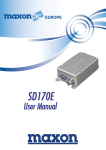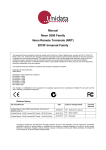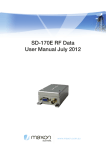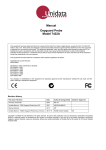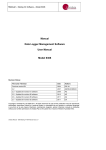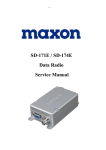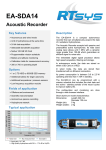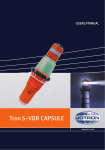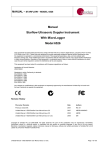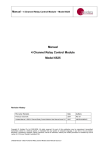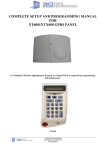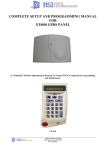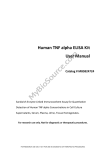Download 2016F GSM 3G NRT Family
Transcript
Manual Neon 2000 Family Neon Remote Terminals (NRT) 2016F GSM 3G This equipment has been tested and found to comply with the limits for a Class A digital device, pursuant to Part 15 of the FCC Rules in the U.S.A. These limits are designed to provide reasonable protection against harmful interference when the equipment is operated in a commercial environment. This equipment generates, uses, and can radiate radio frequency energy and, if not installed and used in accordance with the instruction manual, may cause harmful interference to radio communications. Operation of this equipment in a residential area is likely to cause harmful interference in which case the user will be required to correct the interference at his own expense. This equipment has been tested for compliance with European regulations as follows: Application of Council Directive: 2004/108/EC Standards to which Conformity is declared: EN-61000-6-1:2001 EN-61000-4-2:1995 EN-61000-4-3:1995 EN-61000-4-4:1995 EN-61000-4-6:1996 ENV-50204:1995 Any changes or modifications to this equipment not expressly approved by the manufacturer Unidata Pty Ltd could void the user’s authority to operate this equipment. Revision History File name/Revision Date Author & Change Details Unidata Manual - Neon 2000 Family Remote Terminals and Modules issue 4.0 25/09/2013 MP – Reformat for web site Unidata Manual – 2016E GSM 3G NRT Family - 28 05 2015.docx 28 05 2015 PC – Major Update Unidata Manual - 2016F GSM 3G NRT Family – 09 06 2015.docx 09 06 2015 PC – Reviewed Checked/ approved Copyright © Unidata Pty Ltd 2000-2013. All rights reserved. No part of this publication may be reproduced, transmitted, transcribed, stored in a retrieval system, or translated into any spoken or computer language, in any form or by any means. Electronic, mechanical, magnetic, optical, chemical, manual or otherwise, without prior written permission of Unidata Pty Ltd 40 Ladner St, O’Connor Western Australia 6163. Manual – 2016F GSM 3G NRTs TABLE OF CONTENTS 1.0 2.0 Neon Technology and Modules Overview ........................................................................ 3 1.1 Typical Neon Measurement System ................................................................................... 4 1.2 The Internet ......................................................................................................................... 4 1.3 GSM .................................................................................................................................... 4 1.4 GPRS .................................................................................................................................. 5 1.5 3G ........................................................................................................................................ 5 1.6 Satellite Packet Data Service .............................................................................................. 5 1.7 NRT Internal Architecture .................................................................................................... 6 Summary of Neon Remote Terminals ............................................................................... 7 2016F Neon Remote Terminal – GSM 3G .......................................................................... 8 2.1 3.0 NRT LED indicator .............................................................................................................. 8 4.0 NRT Setup and Test ............................................................................................................ 9 5.0 NRT Power Requirements .................................................................................................. 9 Internal Power ..................................................................................................................... 9 External Power .................................................................................................................... 9 Battery Life Table ................................................................................................................ 9 5.1 5.2 5.3 6.0 NRT Installation ................................................................................................................. 10 SIM Card Recommendations ............................................................................................ 10 Neon Setup Recommendations ........................................................................................ 10 NRT Connections .............................................................................................................. 10 6.1 6.2 6.3 7.0 NRT Commissioning ......................................................................................................... 11 NRT Powered On .............................................................................................................. 11 NRT Confirm Configuration ............................................................................................... 11 NRT Signal Strength Verification....................................................................................... 12 NRT Initialisation ............................................................................................................... 12 7.1 7.2 7.3 7.4 8.0 9.0 SIM Card Installation......................................................................................................... 15 Battery Testing .................................................................................................................. 17 Battery Check .................................................................................................................... 17 Battery Replacement ......................................................................................................... 17 9.1 9.2 Unidata Manual - 2016F GSM 3G NRT Family - 09 06 2015.docx Page 1 Manual – 2016F GSM 3G NRTs References This manual should be read in conjunction with the associated StarlogV4 User Manual which describes the setting up of logging schemes for NRT terminals as well as all other Unidata Data loggers. This manual should also be read in conjunction with the Neon Server Documentation which is available in PDF form from the Unidata web site and is also available as help screens within the Neon Server system. The NRT Terminal User Manual, the StarlogV4 User Manual and the Neon Server User & Administrator Documentation form part of the documentation suite for the overall Neon System. Unidata Manual - 2016F GSM 3G NRT Family - 09 06 2015.docx Page 2 Manual – 2016F GSM 3G NRTs 1.0 NEON TECHNOLOGY AND MODULES OVERVIEW Neon is a system for collecting measurements from field instruments and transmitting the measurements to a central system for data recording, analysis, reporting and data transfer to other external systems. The Neon system also provides facilities for data collection, analysis, reporting and field measurement equipment and management within specified areas as defined by the system. Examples of this include country wide access, regional access and different access levels according to the rights and privileges of users, e.g. supervisor level, manager level, coordinator level and read only user level. The Neon System is suited to a range of uses such as environmental monitoring of remote instrumentation and automated industrial and utility metering. The Neon system may be offered on a system basis, with the customer purchasing the server and a software license from Unidata, or can be provided on an application service basis where the customer pays a service fee for Unidata to run the application on a Unidata central server. Overview of the Neon System Unidata Manual - 2016F GSM 3G NRT Family - 09 06 2015.docx Page 3 Manual – 2016F GSM 3G NRTs 1.1 Typical Neon Measurement System The figure above is an example of a Neon installation showing an NRT connected to a Water Level Instrument. Every day the NRT will send a “packet” of information containing the data in raw format via GSM / 3G to the Neon server. The Neon server extracts the raw data from the packet. The data is then stored on a secure server until the client accesses the data using a standard Web Browser. 1.2 The Internet The Internet provides the transport mechanism between the Neon Servers and the telecommunication provider gateways. This means that NRT units can be used anywhere in the world. 1.3 GSM GSM (Global System Mobile) is a cell phone standard developed for second-generation (2G) digital cellular networks used by mobile phones in most parts of the world. GSM provides the “backbone” upon which GPRS, voice and data communication travel. GPRS (General Packet Radio Service) is an IP-enabled cellular solution for urban communications. The power requirements are low and the GPRS electronics are fully integrated within the NRT. GPRS communications are generally available wherever GSM communications are available. By this means a logger or field instrument connected to a GPRS-enabled communications device (such as a Neon NRT) can deliver data to any Internet connected computer. GPRS provides an always-connected service – i.e. there is no dial up required. Typically the user pays for data use and not for time. Unidata Manual - 2016F GSM 3G NRT Family - 09 06 2015.docx Page 4 Manual – 2016F GSM 3G NRTs 1.4 GPRS GPRS (General Packet Radio Service) is an IP-enabled cellular solution for urban communications. The power requirements are low and the GPRS electronics are fully integrated within the NRT. GPRS communications are generally available wherever GSM communications are available. By this means a logger or field instrument connected to a GPRS-enabled communications device (such as a Neon NRT) can deliver data to any Internet connected computer. GPRS provides an always-connected service – i.e. there is no dial up required. Typically the user pays for data use and not for time. 1.5 3G 3G is the third generation of mobile telecommunications technology. faster information transfer rates. 1.6 3G provides for Satellite Packet Data Service There are several low earth orbit and equatorial orbit packet data service providers. The NRT Satellite uses either the Globalstar system or the Inmarsat system. The Globalstar system provides a service very similar to the Cellular based GSM GPRS service except via a satellite network. The Inmarsat system provides IP (Internet Protocol) connectivity via the international Inmarsat GEO Satellite network from any location on the globe, except the Arctic and Antarctica. The Inmarsat system is used by Ethernet models of NRT. Unidata Manual - 2016F GSM 3G NRT Family - 09 06 2015.docx Page 5 Manual – 2016F GSM 3G NRTs 1.7 NRT Internal Architecture The NRT Internal architecture is shown below. It contains two discrete sections, A LOGGER section where the terminal connects to the field transducers and the logging scheme, scan rates and diagnostics are managed. The StarlogV4 support software allows a user to generate a logger scheme which defines transducer information, logging scan rates, logger interval etc and various engineering unit definitions. These files are called, for example the LDR and KBD files. A COMMUNICATOR section which deals with communications to the server. This section contains, for example, a scheduler component and the modem component, either a Cellular Network modem or a Satellite Network modem. The communicator manages functions such as the reporting interval, the number of communications attempts per communications session, etc. The StarlogV4 support software allows a user to generate a configuration file for the Communicator section, called an FPO file in which the user sets the required communications parameters. Unidata Manual - 2016F GSM 3G NRT Family - 09 06 2015.docx Page 6 Manual – 2016F GSM 3G NRTs 2.0 SUMMARY OF NEON REMOTE TERMINALS Neon Remote Terminals (NRT units) are small, ultra-low power microprocessor-based devices designed to collect data from data loggers and SDI-12 instruments. This data is then sent via Cellular Networks or Satellite packet data to a Neon server on a programmed schedule or as required for alerts. The NRT also incorporates a fully-programmable data logger so that simple analogue and digital signals may be directly connected and recorded. NRTs are classified according to the communications network over which they communicate. That is as either: Terrestrial (Cellular), Satellite (Globalstar or Inmarsat) or Ethernet. There are many different models of Neon Metering Modules. Plastic case models are referred to as Neon Metering Modules (NMMs), Plastic case models with an LCD are referred to as Neon Remote Modules (NRMs) and Metal enclosure models are referred to Neon Remote Terminals (NRTs). This manual refers to all NMMs/NRMs/NRTs as NRTs because all 2016F’s are NRTs. All Neon Remote Terminals are small self-contained units in compact cases that connect to sensors in the field, collect readings from those sensors and transmit the collected data to a central Neon server. The type of network over which the collected data is transmitted varies from model to model. The Neon central server system can be provided either on a Neon Data Service basis or on a Neon Client System basis. Both provide a central computer system to monitor and receive data from many Neon Remote Terminals in the field. All Neon Remote Terminals are designed to automate collection of remote data from environmental monitoring, industrial measurements and utility metering via a communications network from any location within the network coverage area. Fully bi-directional communications are possible via the Neon server. Data can be collected directly and the Neon module can be programmed from any internet connection. The Neon modules also support integrated logging or automated collection of data from an external data logger. All Neon Remote Terminals utilise built-in modems that support packet data. They have long battery life and low operating costs through use of advanced microcontroller technology. All Neon Remote Terminals provide Input /Output functions as standard, including analog and digital inputs and SDI-12 data logger interface. There is also Modbus support via a partial implementation of the Modbus protocol, which allows for reading from and writing to specific registers within the Modbus RTU on an RS485 connection. Further details are available on request. Unidata Manual - 2016F GSM 3G NRT Family - 09 06 2015.docx Page 7 Manual – 2016F GSM 3G NRTs 2.1 2016F Neon Remote Terminal – GSM 3G The 2016F NRT GSM 3G is a small self-contained metal cased Neon Remote Terminal that communicates with the Neon server via GSM 3G cellular telephone networks. 3.0 NRT LED INDICATOR The simplest indicator is the red LED which is visible in the window of the unit. On first power on the LED will be brightly on (not flashing) for 10 seconds indicating the unit is in the process of being reset. Do not interrupt this initial start-up process. If the initial start-up is interrupted you should power down, wait a few minutes, and then power up again. Slow flashing bright LED. One flash per second indicates the NRT is establishing a network connection via the internal modem. This process takes approximately 10 to 20 seconds. Fast flashing bright LED. 3 to 5 flashes per second indicate the PPP session is running and the NRT is communicating through the internal modem to the host server. If the NRT is programmed to hold the PPP session open all the time, i.e. the always on mode, the LED will continue to flash at this rate. Slow brief flashing (dim) LED. One dim flash every Scan Interval (typically every 5 seconds) indicates normal NRT operation (sleeping). No communication is in progress. The NRT has been programmed to log data and will only establish communications at the defined reporting interval with which it has been configured. Very occasional bright single flash. This indicates the scheme is actively logging rather than sleeping at that particular time. If you have a scheme which has a 5 second Scan rate and a 1 minute Log Interval, you will see dim flashes (indicating sleep) every 5 seconds (i.e. every scan interval), then one bright flash on the minute, indicating that a log is in progress. This cycle repeats at the Log Interval, hence the LED will brightly flash every 1 minute. When the NRT periodically communicates with the Neon server, the LED will slowly flash as it establishes a network connection, then quickly flash while it actually communicates with the Neon server (uploads log data, downloads its scheme, processes queued commands, etc), then slowly flash as it disconnects from the network The durations of each stage will vary according to the telemetry type of the NRT and how much data is transferred between the NRT and Neon server. If an NRT has been configured on the Neon server to Auto Cold Boot, then after the 10 second start up illumination, the NRT will immediately start a normal comms cycle, as previously described, following the normal slow flashing, fast flashing, slow flashing cycle. Unidata Manual - 2016F GSM 3G NRT Family - 09 06 2015.docx Page 8 Manual – 2016F GSM 3G NRTs 4.0 NRT SETUP AND TEST The 2016F NRT uses a SIM card which needs to be installed. It should then connect to the Cellular network within a few seconds of powering on. Note the SIM card must have the security PIN number switched off or disabled. This needs to be done by using the SIM card in a normal mobile phone. 5.0 NRT POWER REQUIREMENTS 5.1 Internal Power 2016F NRTs can be powered by internal batteries and / or with an external battery supply. The recommended batteries are SAFT Lithium batteries which are specified in this manual. The Lithium batteries provide high inrush current required for modern cellular hand phones. The 2016F NRT has one Lithium Battery for the internal battery supply. 5.2 External Power If required the NRT can be powered by an external supply of 6 to 16VDC @ 2A peak (while transmitting) and 25mA (while receiving) and 30uA while on standby. Unidata recommends 12V 7.2AH SLA (Sealed Lead Acid) batteries as a good external supply. External instrumentation must be separately powered if more than 500uA is required. The download schedule is the largest consumer of power. The Continuous Drain Equivalent rating can be used to size the external power requirements and duration of external power supplies. However, external power sources should have an additional 100uA at 12V or 50uA at 6V continuous drain added, (due to parasitic losses in the NRT circuitry). The decision to use an external power supply should be based on the projected or known frequency of battery changes, i.e. if a high download schedule is required and frequent battery replacement is going to prove difficult or expensive, then an external power supply is desirable. 5.3 Battery Life Table Approximate NRT Lithium Battery Life Approximate Download Schedule 5 years 1 per day 5 secs 15 minutes 0.12 mA 4 years 4 times per day 5 secs 15 minutes 0.21 mA 1 year 1 per hour 5 secs 15 minutes 0.53 mA 52 days 1 per 5 minutes 5 secs 1 minute 5.2 mA 5 seconds 26 mA 10 days Approximate Approximate Scan Rate Log Interval 1 per minute 5 secs Table 1 Unidata Manual - 2016F GSM 3G NRT Family - 09 06 2015.docx Approximate Continuous Drain Equiv Page 9 Manual – 2016F GSM 3G NRTs 6.0 NRT INSTALLATION The following section describes the NRT installation procedure. The installation process is similar for all models. 6.1 SIM Card Recommendations It is highly recommended that the SIM is installed in the NRT before going to site. Refer to sections 8.0 for detailed SIM setup installation. It is also recommended that the contents of the NRT installation kit are checked, and that the NRT is tested and confirmed as working before going to site. Even if wireless communication cannot be verified (for example due to coverage issues), the NRT can still be checked to ensure it has a battery and is powered on, and that communication with a laptop computer is possible. Note that high signal strength for the NRT will minimise current drain – and prolong battery life. 6.2 Neon Setup Recommendations The NRT should be registered as part of a scheme before being installed in the field. This will allow for commissioning of the NRT and verification that communications can be established between the NRT and the Neon server. Once in the field the NRT should be placed in the area of greatest signal strength. A good test for this is to use a mobile phone using the same carrier as the NRT, as the signal strength indicator will show the best location. Note that due to the slow refresh rate of the mobile phone signal strength indicator, it is necessary to hold the mobile phone in place for between 30 to 60 seconds to obtain an accurate reading. If a mobile phone on the same carrier network is not available it is possible to use the NRT itself to determine signal strength. Avoid installing the NRT enclosure in direct sunlight, as cool operating temperatures will aid longevity of the internal components. Avoid placing the NRT enclosure inside a metal box, or in an area with large amounts of metal around the NRT enclosure, as this can adversely affect the communication abilities of the NRT. If the NRT must be located within a metal enclosure, an external antenna will be required. Install the NRT enclosure in a secure location to avoid tampering and vandalism. Position the enclosure to ensure cables from NRT to field devices are as short as practical. If the NRT is to be used for real-time communication or for a higher than usual download schedule (refer to Table 1), an external power supply may be required to avoid frequent battery replacement. Provision for this should be considered during the installation, such as installing the NRT within range of a mains power outlet. 6.3 NRT Connections NRT wiring connections are listed in the separate “Unidata Manual - NRT Family Cables & Connection Supplement” companion document. Unidata Manual - 2016F GSM 3G NRT Family - 09 06 2015.docx Page 10 Manual – 2016F GSM 3G NRTs 7.0 NRT COMMISSIONING Once the NRT has been installed and all connections made, field commissioning can be conducted. Ensure that a SIM card has been installed (see next section). Commissioning tests may be performed as follows. 7.1 NRT Powered On Confirm that the status LED, visible through the transparent window on the front of the unit, is flashing. With the NRT in an idle state the LED will flash faintly once every second. 7.2 NRT Confirm Configuration Confirm proper configuration by connecting the NRT to a laptop computer running StarlogV4. Launch the STARLOGV4 (laptop computer) application. Press the ‘Select’ icon and select the scheme corresponding to the NRT Click on the ‘Configure/Initialise’ button to open the “NRT/NMM Configuration Tool” dialog Press the ‘Retrieve NRT Settings’ button at top right of the dialog Confirm that the correct Server IP address has been configured Confirm that the correct NRT ID (XRTID) has been configured Check the firmware version and NRT Model type If all checks are confirmed, the NRT may be Initialised Unidata Manual - 2016F GSM 3G NRT Family - 09 06 2015.docx Page 11 Manual – 2016F GSM 3G NRTs 7.3 NRT Signal Strength Verification Connect a laptop computer to the NRT. Launch the STARLOGV4 application. Press the ‘Select’ icon and select the scheme corresponding to the NRT. Click on the ‘Configure/Initialise’ button to open the “NRT/NMM Configuration Tool” dialog Press the ‘Retrieve NRT Settings’ button at top right of the dialog Press the ‘Signal Strength’ button. After a short delay (10 seconds or so), the RSSI signal strength will be displayed. RSSI must be 16 or higher. If it is 99 then there is no connection to the cellular network. 7.4 If there is sufficient signal, press the Cancel button to exit the Signal Strength option. NRT Initialisation Reconnect to the NRT if not already connected. Launch STARLOGV4 (laptop computer) application. Press the ‘Select’ icon and select the scheme corresponding to the NRT Click on the ‘Configure/Initialise’ button to open the “NRT/NMM Configuration Tool” dialog Press the ‘Retrieve NRT Settings’ button at top right of the dialog Unidata Manual - 2016F GSM 3G NRT Family - 09 06 2015.docx Page 12 Manual – 2016F GSM 3G NRTs Press the ‘Initialise’ button The NRT will attempt to communicate with the Neon server and initialise itself. Once communications have been established, the NRT will download any required scheme and configuration files and complete the initialisation process. The NRT should respond with a PASS message after 2 or 4 minutes. Please be patient waiting for this message. Unidata Manual - 2016F GSM 3G NRT Family - 09 06 2015.docx Page 13 Manual – 2016F GSM 3G NRTs Common Initialisation failure codes and their causes are illustrated in the table below Once all commissioning tests have been completed successfully, the NRT is fieldcommissioned and ready for use. Unidata Manual - 2016F GSM 3G NRT Family - 09 06 2015.docx Page 14 Manual – 2016F GSM 3G NRTs 8.0 SIM CARD INSTALLATION The following section describes the procedure for installing a SIM into an NRT. This section only needs to be performed if the SIM within the NRT needs replacing or if it is known that the NRT does not contain a SIM. Remove the lid screws (either two or four screws depending on model). WARNING: Care should be taken when handling lithium batteries as misuse may cause damage to the NRT or the battery cells may explode. Ensure that the battery terminals are NOT shorted and that there are no loose wires in the vicinity the battery. Remove the battery from its holder. Locate the SIM socket. Slide the SIM cover gently with a fingernail or matchstick until it clicks. The SIM cover can now be lifted gently and hinged open. Insert the SIM with the gold contacts away from you and the cut corner at the top left as shown below SIM card inserted. Close the SIM cover and slide it into place until it clicks. Unidata Manual - 2016F GSM 3G NRT Family - 09 06 2015.docx Page 15 Manual – 2016F GSM 3G NRTs SIM card installed. Replace the battery, ensuring correct polarity. Return the NRT assembly carefully to the case, ensuring the antenna stub is correctly located in its aperture. Secure the NRT end plate with the four screws. Re-attach the antenna. Unidata Manual - 2016F GSM 3G NRT Family - 09 06 2015.docx Page 16 Manual – 2016F GSM 3G NRTs 9.0 BATTERY TESTING 9.1 Battery Check The presence of a battery can be verified without opening the NRT. Look for the flashing LED through the window on the front of the NRT unit. If the NRT is in an idle state, the LED will flash faintly once every second. If the LED is not flashing, you will need to open the NRT and verify the presence of a battery: If a battery is installed and the LED is not flashing, the NRT will need to be initialised. (See section on NRT Initialisation). 9.2 Battery Replacement Always wait at least 1 minute between removing a battery and either replacing the same battery or inserting a new battery. This is to allow any residual charge within the NRT to dissipate. The NRT battery should only be replaced with a SAFT LSH20. This is a spiral wound Lithium Thionyl Chloride [Li-SOCl2] battery with a terminal voltage of 3.6 volts. Failure to replace the battery with the correct type may cause communication failure. For further information on the battery and where to purchase replacements, please refer to www.saft.com WARNING: Care should be taken when handling lithium batteries as misuse may cause damage to the NRT or the battery cells may explode. Ensure that the battery terminals are NOT shorted and that there are no loose wires in the vicinity of the battery. Unidata Manual - 2016F GSM 3G NRT Family - 09 06 2015.docx Page 17



















